Tribological Properties of Glass Bead-Filled Polyamide 12 Composite Manufactured by Selective Laser Sintering
Abstract
1. Introduction
2. Experimental Methods
2.1. SLS of Test Specimens
2.2. Pin-on-Disc Wear Test
2.3. Noise Measurement
2.4. Data Acquisition
2.5. Tribo-Surface Characterization
3. Results and Discussions
3.1. Coefficient of Friction (COF)
3.2. Friction-Induced Noise
3.3. Frictional Heating
3.4. Wear Rate (Wear Coefficient)
3.5. Scanning Electron Microscopy (SEM)
4. Conclusions
Author Contributions
Funding
Institutional Review Board Statement
Data Availability Statement
Acknowledgments
Conflicts of Interest
References
- Goodridge, R.D.; Tuck, C.J.; Hague, R.J.M. Laser sintering of polyamides and other polymers. Prog. Mater. Sci. 2012, 57, 229–267. [Google Scholar] [CrossRef]
- Liu, Y.; Zhu, L.; Zhou, L.; Li, Y. Microstructure and mechanical properties of reinforced polyamide 12 composites prepared by laser additive manufacturing. Rapid Prototyp. J. 2019, 25, 1127–1134. [Google Scholar] [CrossRef]
- Caulfield, B.; McHugh, P.E.; Lohfeld, S. Dependence of mechanical properties of polyamide components on build parameters in the SLS process. J. Mater. Process. Technol. 2007, 182, 477–488. [Google Scholar] [CrossRef]
- Aldahash, S.A.; Gadelmoula, A.M. Orthotropic properties of cement-filled polyamide 12 manufactured by selective laser sintering. Rapid Prototyp. J. 2020, 26, 1103–1112. [Google Scholar] [CrossRef]
- Gadelmoula, A.M.; Aldahash, S.A. Effects of Fabrication Parameters on the Properties of Parts Manufactured with Selective Laser Sintering: Application on Cement-Filled PA12. Adv. Mater. Sci. Eng. 2019, 2019, 8404857. [Google Scholar] [CrossRef]
- Zhao, M.; Wudy, K.; Drummer, D. Crystallization kinetics of polyamide 12 during Selective laser sintering. Polymers 2018, 10, 168. [Google Scholar] [CrossRef]
- Bai, J.; Song, J.; Wei, J. Tribological and mechanical properties of MoS2 enhanced polyamide 12 for selective laser sintering. J. Mater. Process. Technol. 2019, 264, 382–388. [Google Scholar] [CrossRef]
- Zárybnická, L.; Petrů, J.; Krpec, P.; Pagáč, M. Effect of Additives and Print Orientation on the Properties of Laser Sintering-Printed Polyamide 12 Components. Polymers 2022, 14, 1172. [Google Scholar] [CrossRef]
- Yu, G.; Ma, J.; Li, J.; Wu, J.; Yu, J.; Wang, X. Mechanical and Tribological Properties of 3D Printed Polyamide 12 and SiC/PA12 Composite by Selective Laser Sintering. Polymers 2022, 14, 2167. [Google Scholar] [CrossRef]
- Dooher, T.; Archer, E.; Walls, T.; McIlhagger, A.; Dixon, D. Ageing of laser sintered glass-filled Polyamide 12 (PA12) parts at elevated temperature and humidity. Polym. Polym. Compos. 2021, 29 (Suppl. S9), S1294–S1304. [Google Scholar] [CrossRef]
- Cano, A.J.; Salazar, A.; Rodríguez, J. Effect of temperature on the fracture behavior of polyamide 12 and glass-filled polyamide 12 processed by selective laser sintering. Eng. Fract. Mech. 2018, 203, 66–80. [Google Scholar] [CrossRef]
- Negi, S.; Dhiman, S.; Sharma, R.K. Determining the effect of sintering conditions on mechanical properties of laser sintered glass filled polyamide parts using RSM. Measurement 2015, 68, 205–218. [Google Scholar] [CrossRef]
- O’Connor, H.J.; Dowling, D.P. Comparison between the properties of polyamide 12 and glass bead filled polyamide 12 using the multi jet fusion printing process. Addit. Manuf. 2020, 31, 100961. [Google Scholar] [CrossRef]
- Kundera, C.; Kozior, T. Assessment of mechanical properties of pa 3200 gf polyamide models made by SLS. Czasopismo Techniczne 2018, 11, 181–186. [Google Scholar] [CrossRef]
- Kundera, C.; Kozior, T. The Influence of Selective Laser Sintering Parameters on Tribological Properties of PA 3200 GF Polyamide. Q. Tribol. 2018, 277, 63–69. [Google Scholar] [CrossRef]
- Kundera, C.; Kozior, T. Assessment of Tribological Properties of Polymers used in Additive Technologies SLS and PJM. Tribologia 2016, 269, 73–84. [Google Scholar]
- Palma, T.; Munther, M.; Damasus, P.; Salari, S.; Beheshti, A.; Davami, K. Multiscale mechanical and tribological characterizations of additively manufactured polyamide 12 parts with different print orientations. J. Manuf. Process. 2019, 40, 76–83. [Google Scholar] [CrossRef]
- Bai, J.; Yuan, S.; Chow, W.; Chua, C.K.; Zhou, K.; Wei, J. Effect of surface orientation on the tribological properties of laser sintered polyamide 12. Polym. Test. 2015, 48, 111–114. [Google Scholar] [CrossRef]
- El Magri, A.; Bencaid, S.E.; Vanaei, H.R.; Vaudreuil, S. Effects of Laser Power and Hatch Orientation on Final Properties of PA12 Parts Produced by Selective Laser Sintering. Polymers 2022, 14, 3674. [Google Scholar] [CrossRef]
- Cooke, W.; Anne Tomlinson, R.; Burguete, R.; Johns, D.; Vanard, G. Anisotropy, homogeneity and ageing in an SLS polymer. Rapid Prototyp. J. 2011, 17, 269–279. [Google Scholar] [CrossRef]
- Ajoku, U.; Saleh, N.; Hopkinson, N.; Hague, R.; Erasenthiran, P. Investigating mechanical anisotropy and end-of-vector effect in laser-sintered nylon parts. Proc. Inst. Mech. Eng. 2006, 220, 1077–1086. [Google Scholar] [CrossRef]
- Aldahash, S.A.; Salman, S.A.; Gadelmoula, A.M. Towards selective laser sintering of objects with customized mechanical properties based on ANFIS predictions. J. Mech. Sci. Technol. 2020, 34, 5075–5084. [Google Scholar] [CrossRef]
- Wörz, A.; Drummer, D. Tribological anisotropy of selective laser sintered PA12 parts. Polym. Test. 2018, 70, 117–126. [Google Scholar] [CrossRef]
- Kundera, C.; Kozior, T. Mechanical properties of models prepared by SLS technology. In AIP Conference Proceedings; AIP Publishing: Bydgoszcz, Poland, 2018; Volume 2017. [Google Scholar] [CrossRef]
- Myshkin, N.; Kovalev, A.; Spaltman, D.; Woydt, M. Contact mechanics and tribology of polymer composites. J. Appl. Polym. Sci. 2014, 131, 39870. [Google Scholar] [CrossRef]
- Lee, L.-H. Polymer Science and Technology: Advances in Polymer Friction and Wear; Plenum Press: New York, NY, USA; London, UK, 1974; Volume 5A. [Google Scholar] [CrossRef]
- Hutchings, I.M.; Shipway, P. Tribology: Friction and Wear of Engineering Materials, 2nd ed.; Elsevier: Amsterdam, The Netherlands, 2016. [Google Scholar]
- Wang, L.; He, H.; Lin, R.; Wu, Z.; Wang, Q.; Yang, B.; Chen, R. Study on ameliorating friction noise of ABS materials by lubrication. Polym. Test. 2020, 82, 106307. [Google Scholar] [CrossRef]
- Myshkin, N.K.; Petrokovets, M.I.; Kovalev, A.V. Tribology of polymers: Adhesion, friction, wear, and mass-transfer. Tribol. Int. 2005, 38, 910–921. [Google Scholar] [CrossRef]
- Rosso, S.; Meneghello, R.; Biasetto, L.; Grigolato, L.; Concheri, G.; Savio, G. In-depth comparison of polyamide 12 parts manufactured by Multi Jet Fusion and Selective Laser Sintering. Addit. Manuf. 2020, 36, 101713. [Google Scholar] [CrossRef]
- Sinha, S.; Briscoe, B. Polymer Tribology; Imperial College Press: London, UK, 2009. [Google Scholar]
- Abdelbary, A. Wear of Polymers and Composites; Elsevier: Amsterdam, The Netherlands, 2014; Available online: http://store.elsevier.com/ (accessed on 8 January 2023).
- Bahadur, S. The development of transfer layers and their role in polymer tribology. Wear 2000, 245, 92–99. [Google Scholar] [CrossRef]
- Ye, J.; Khare, H.S.; Burris, D.L. Quantitative characterization of solid lubricant transfer film quality. Wear 2014, 316, 133–143. [Google Scholar] [CrossRef]
- Nunez, E.E.; Polycarpou, A.A. The effect of surface roughness on the transfer of polymer films under unlubricated testing conditions. Wear 2015, 326–327, 74–83. [Google Scholar] [CrossRef]
- Rodiouchkina, M.; Lind, J.; Pelcastre, L.; Berglund, K.; Rudolphi, Å.K.; Hardell, J. Tribological behaviour and transfer layer development of self-lubricating polymer composite bearing materials under long duration dry sliding against stainless steel. Wear 2021, 484–485, 204027. [Google Scholar] [CrossRef]
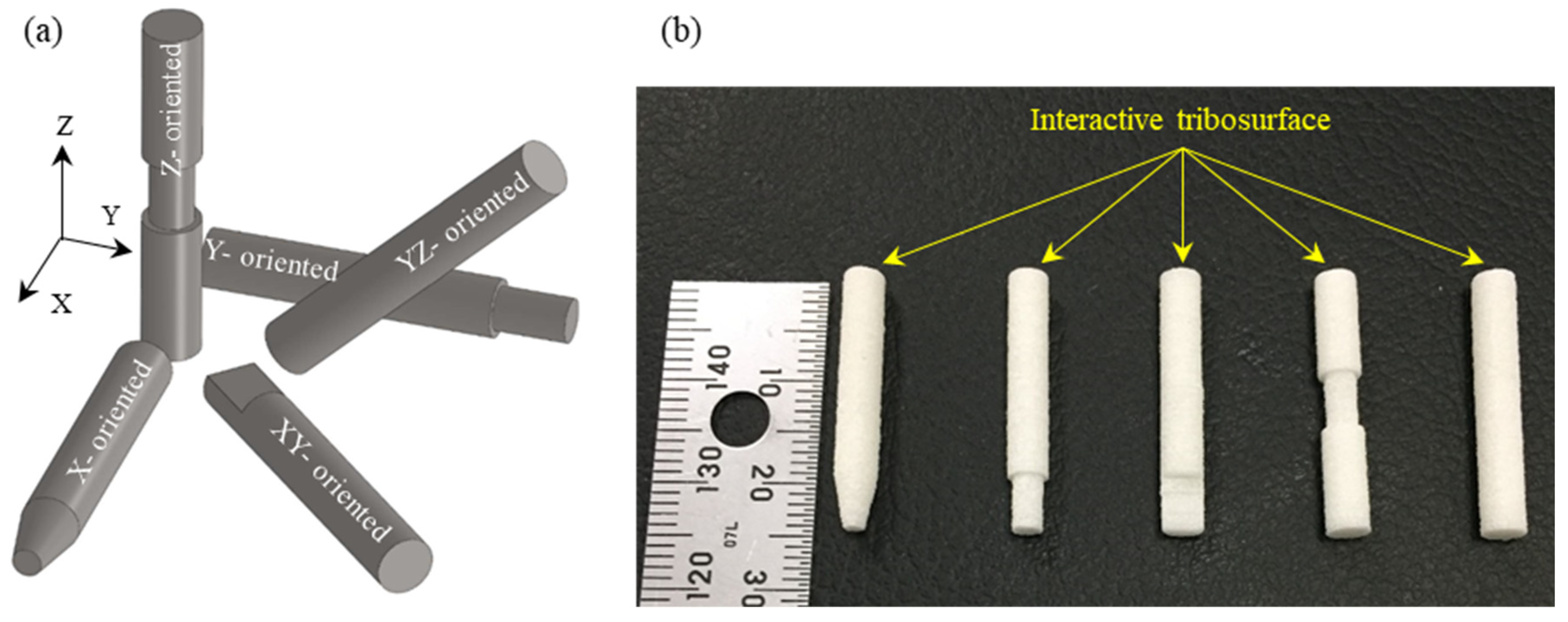
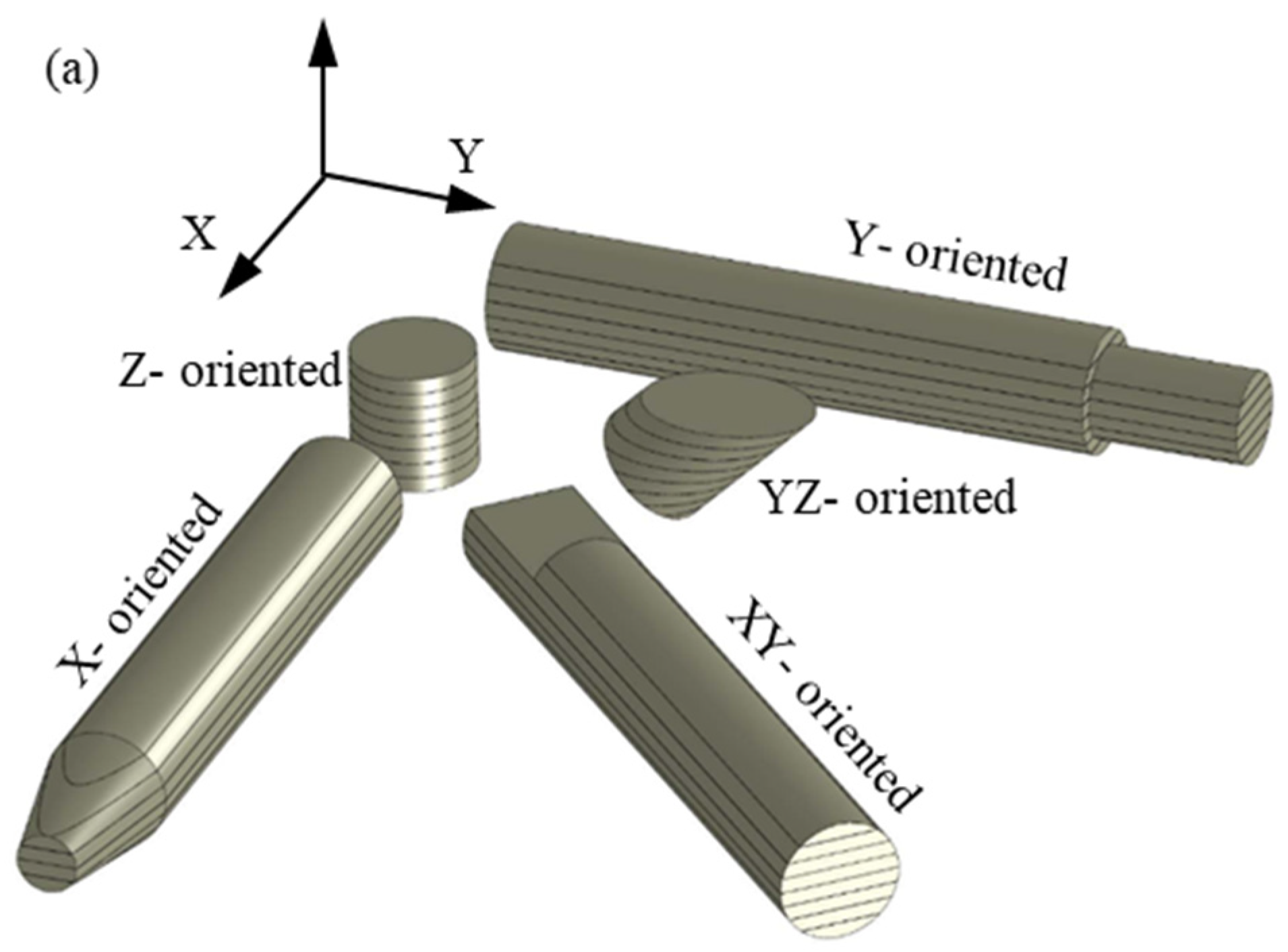
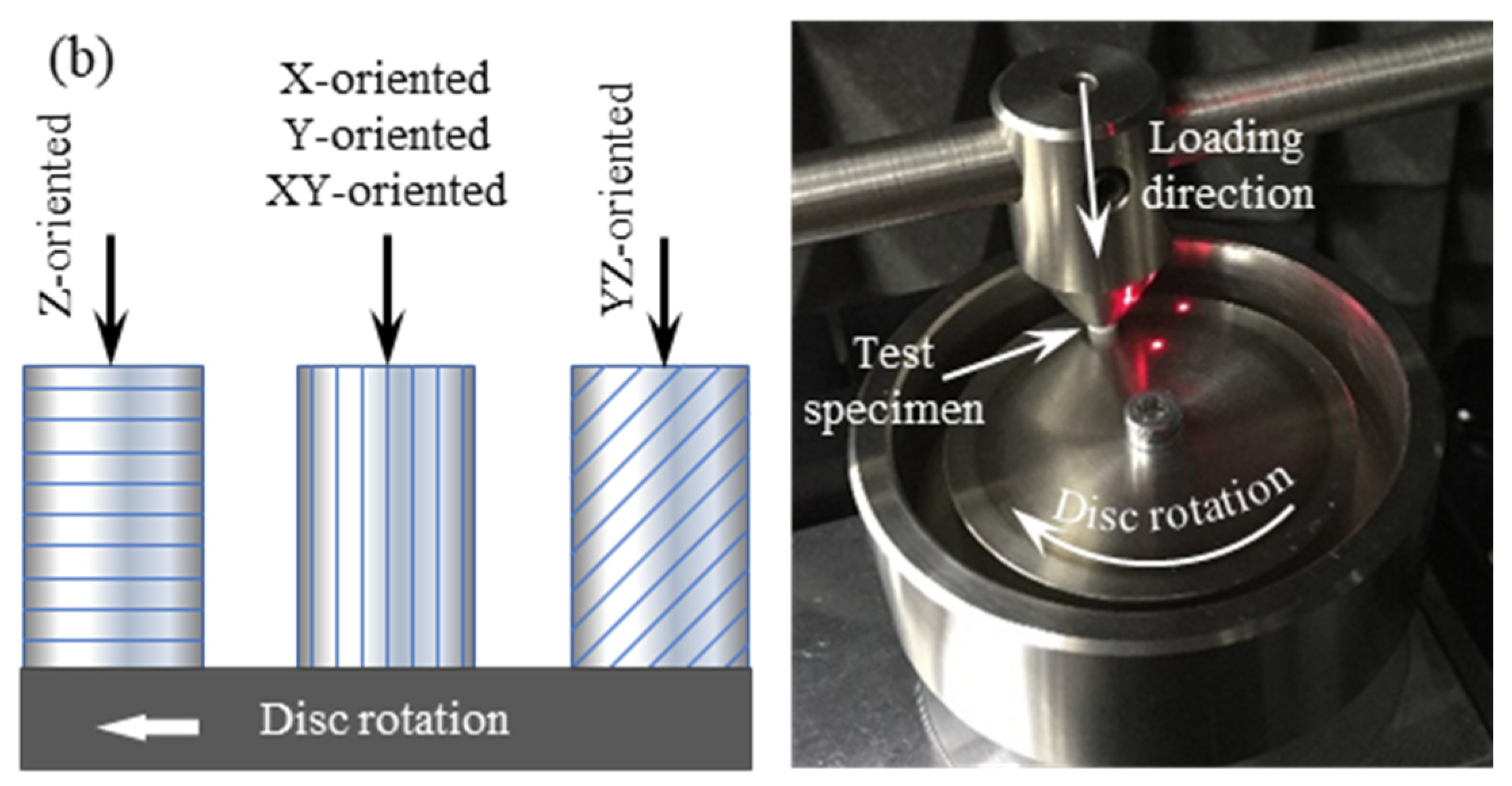
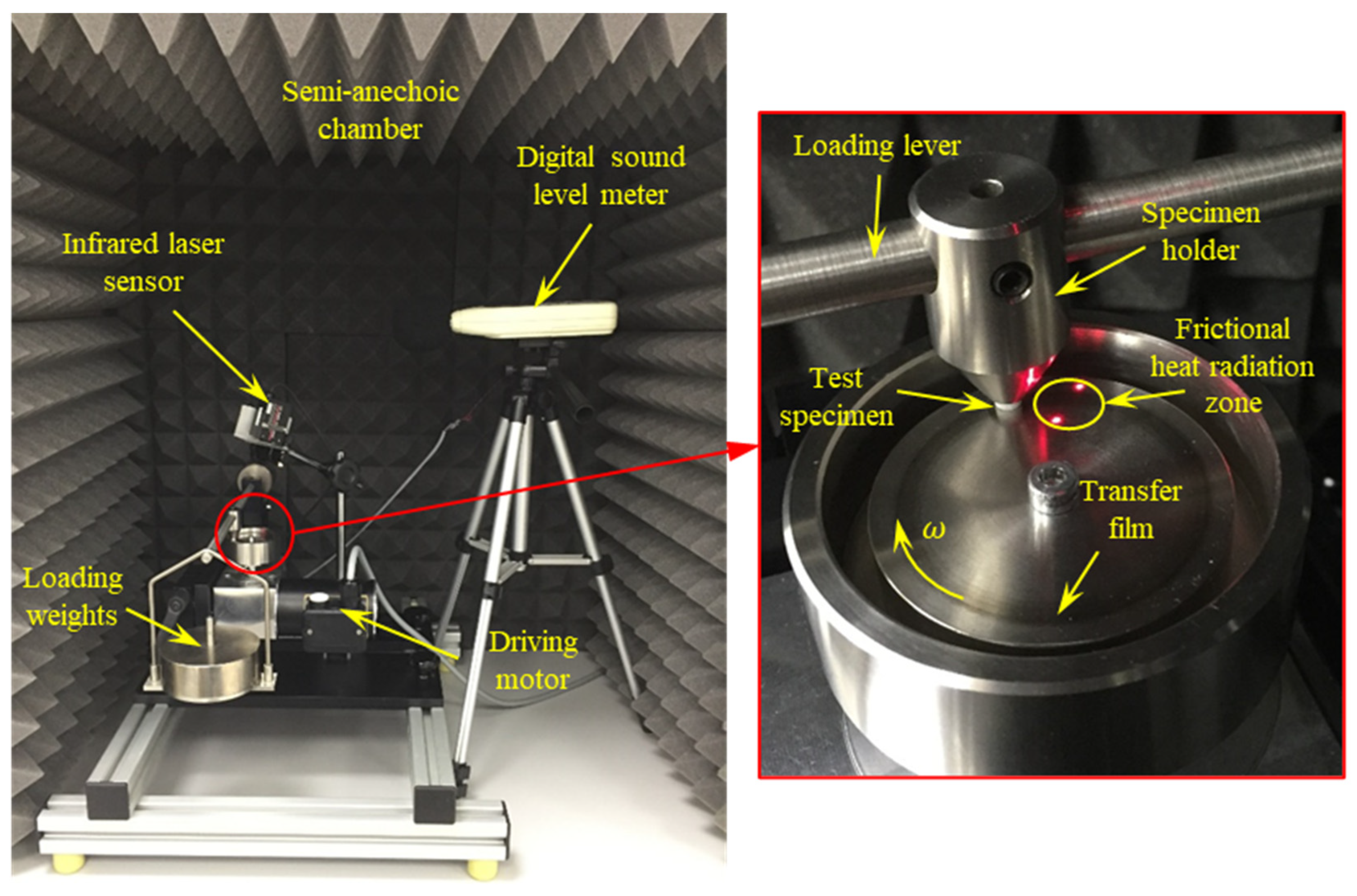
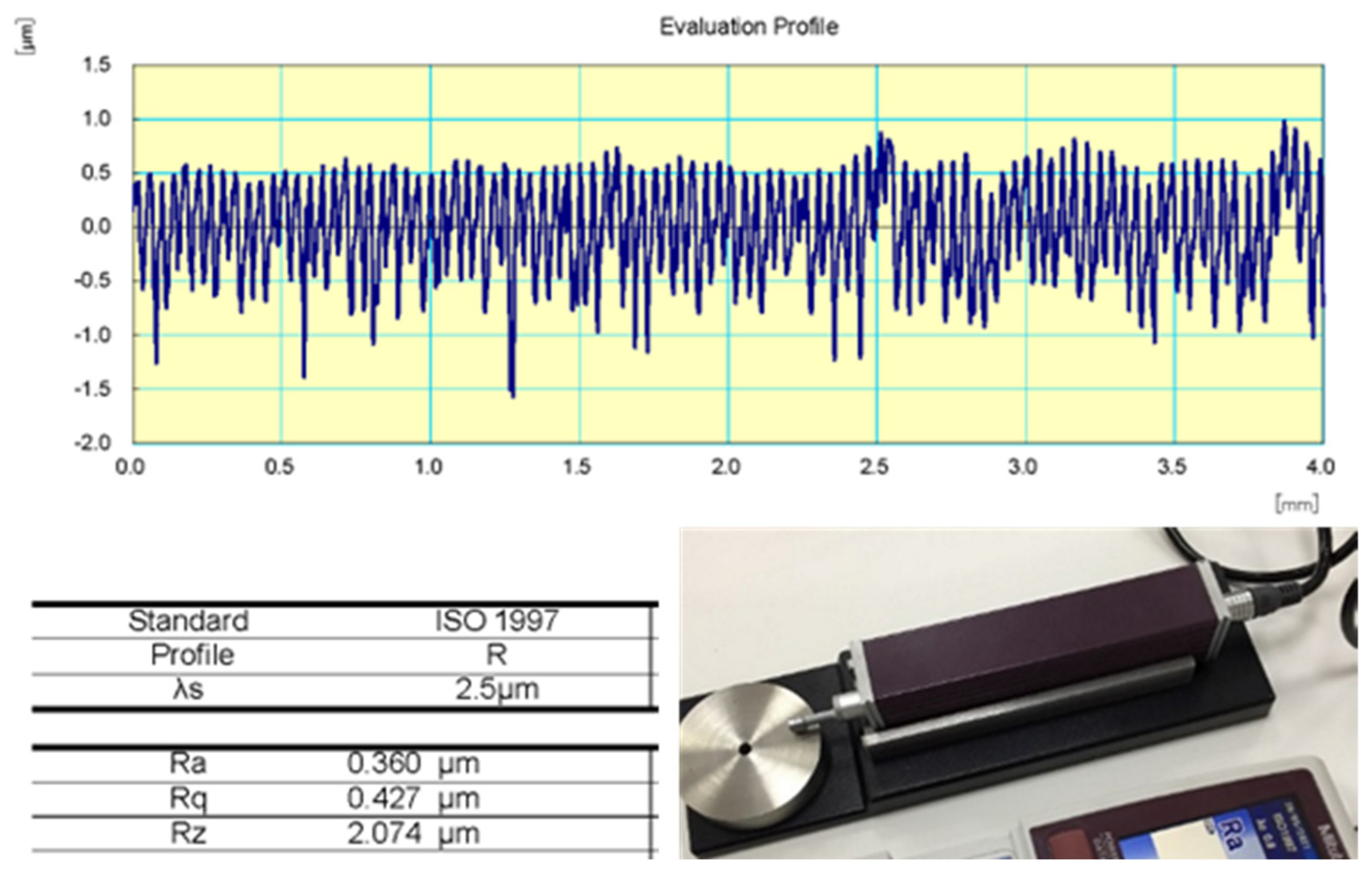
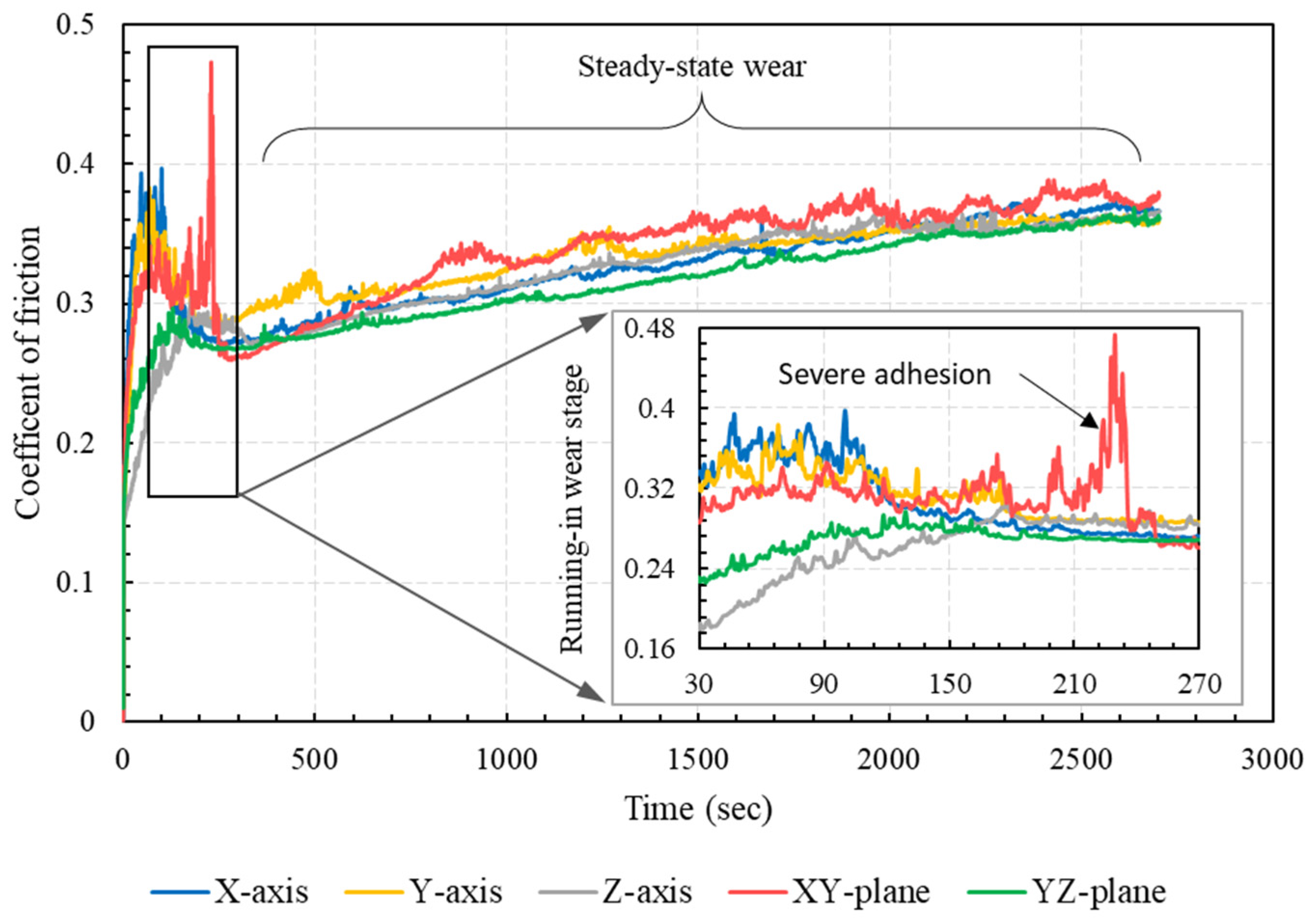
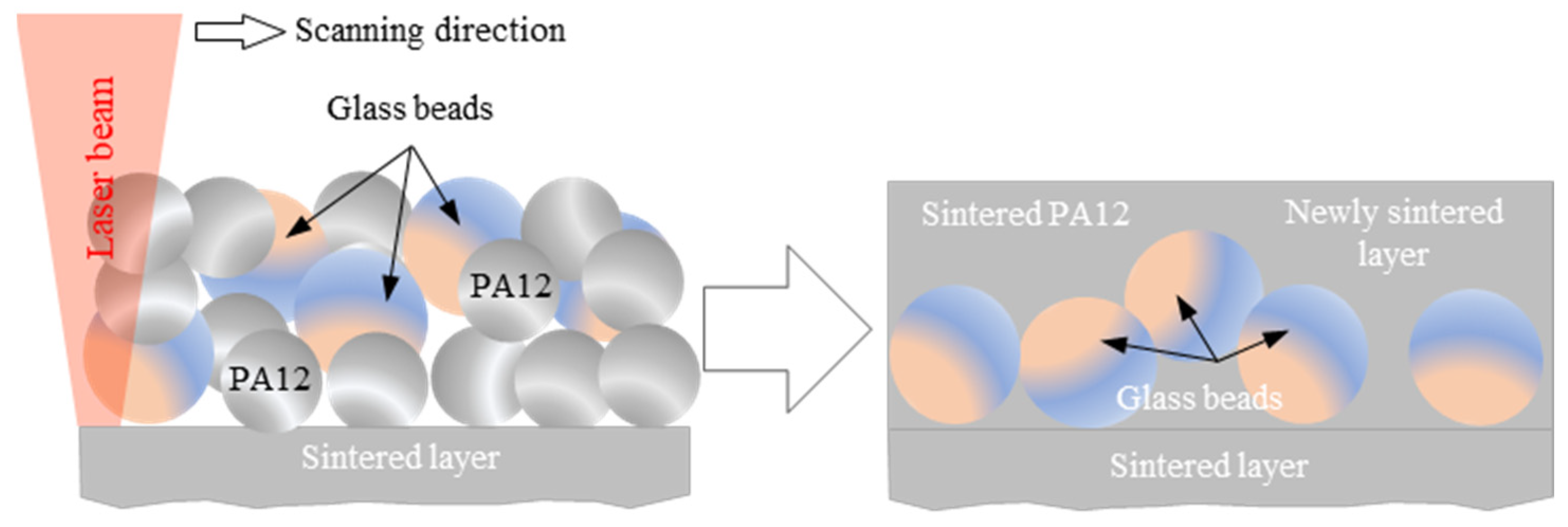
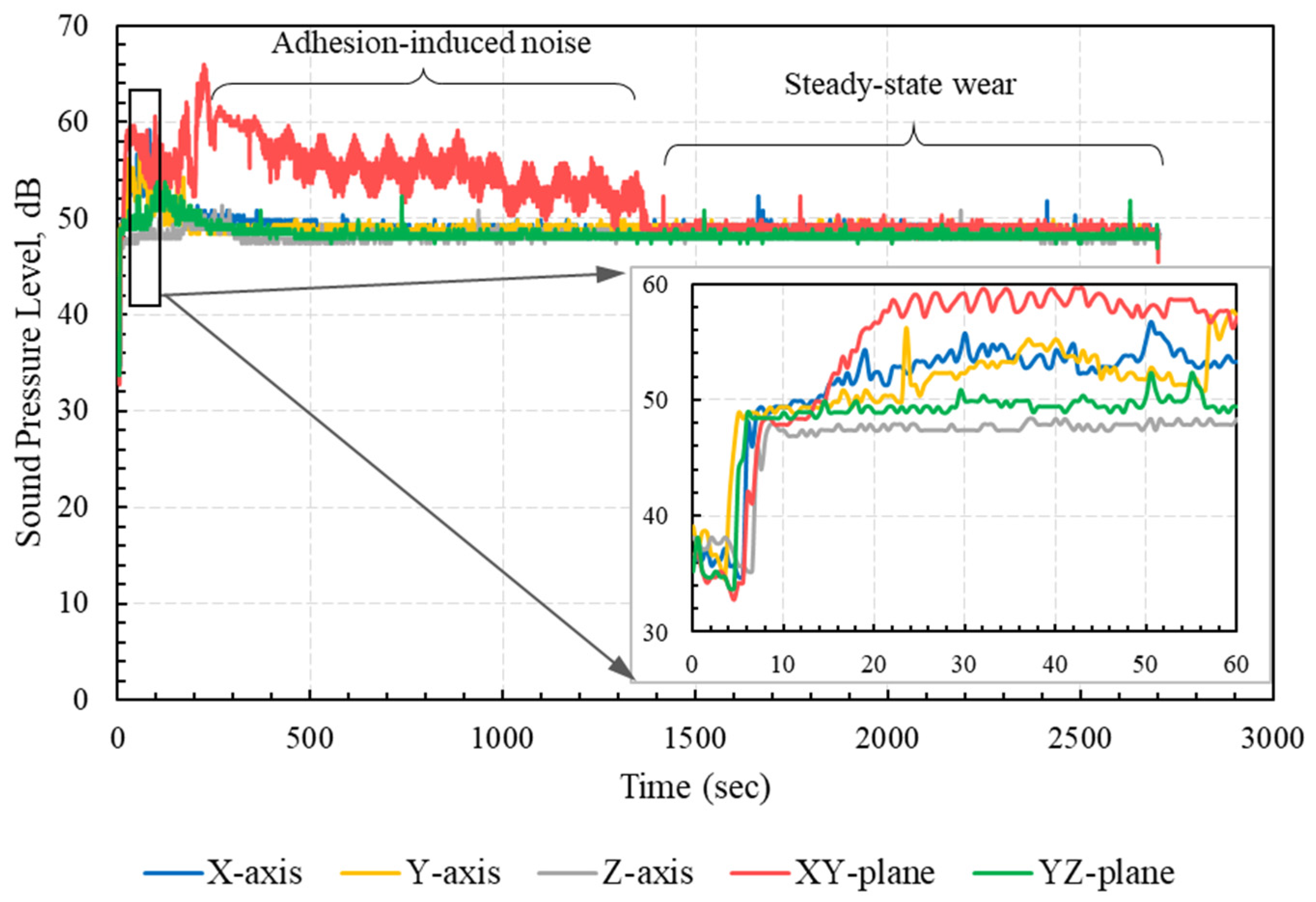
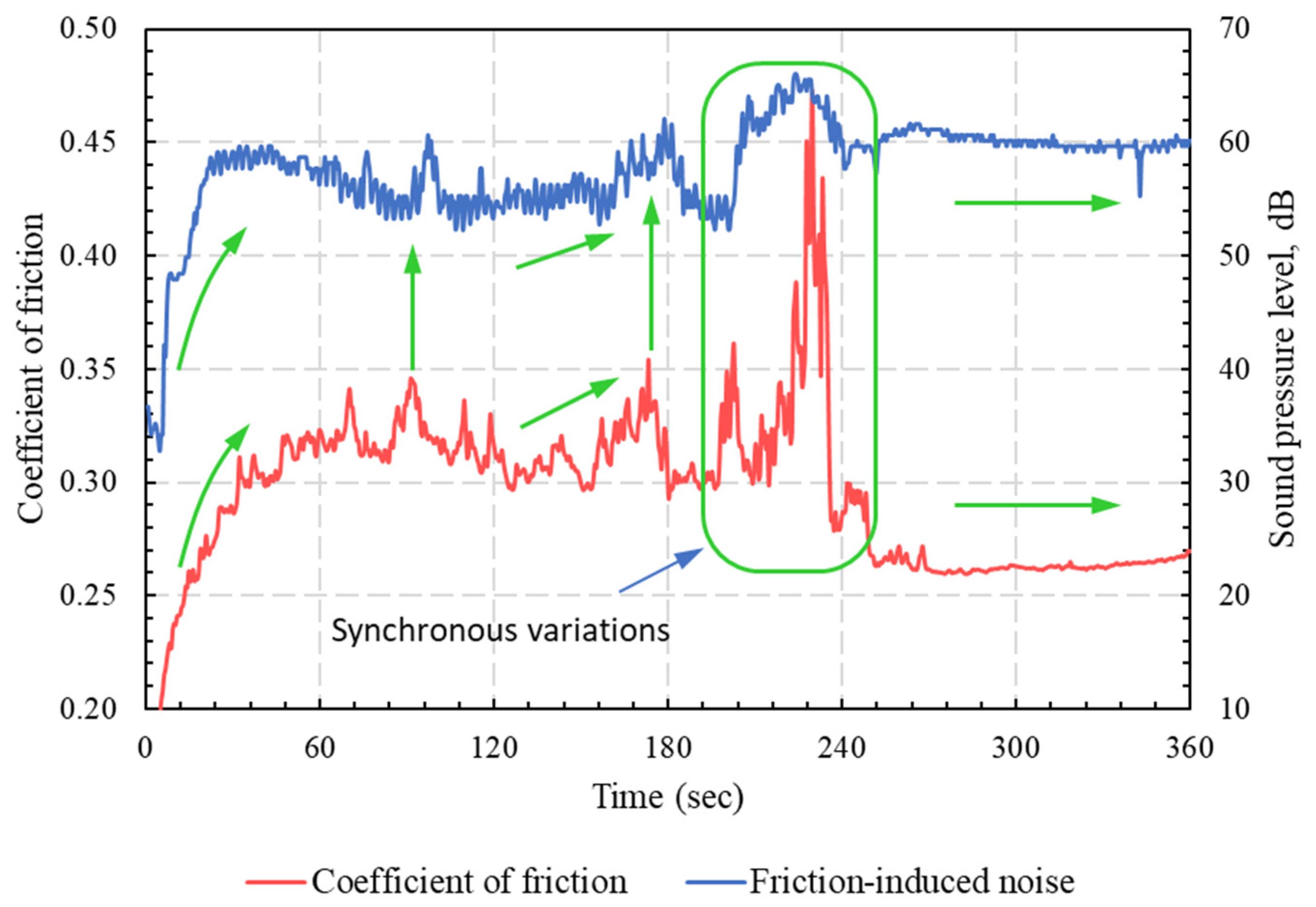
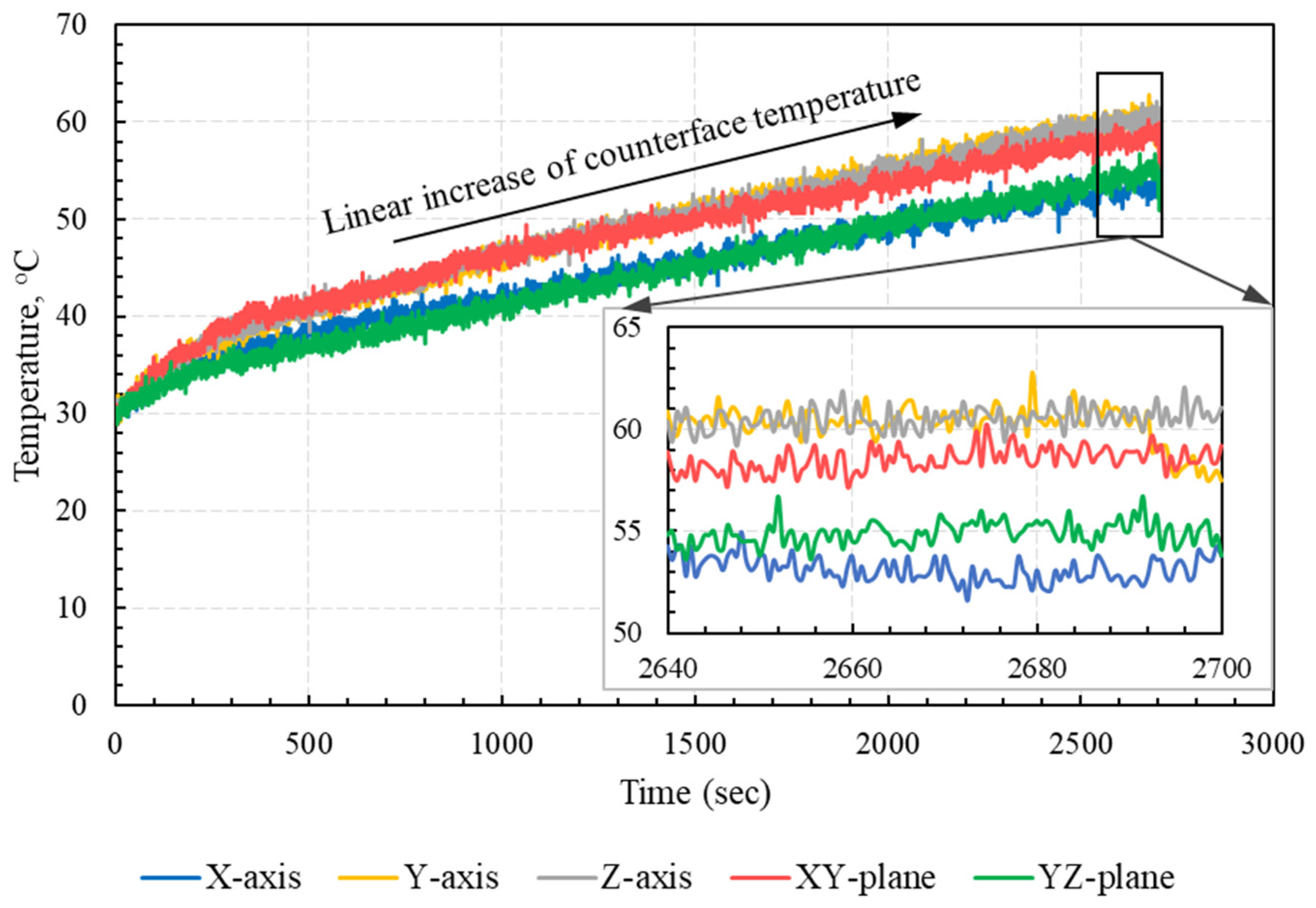
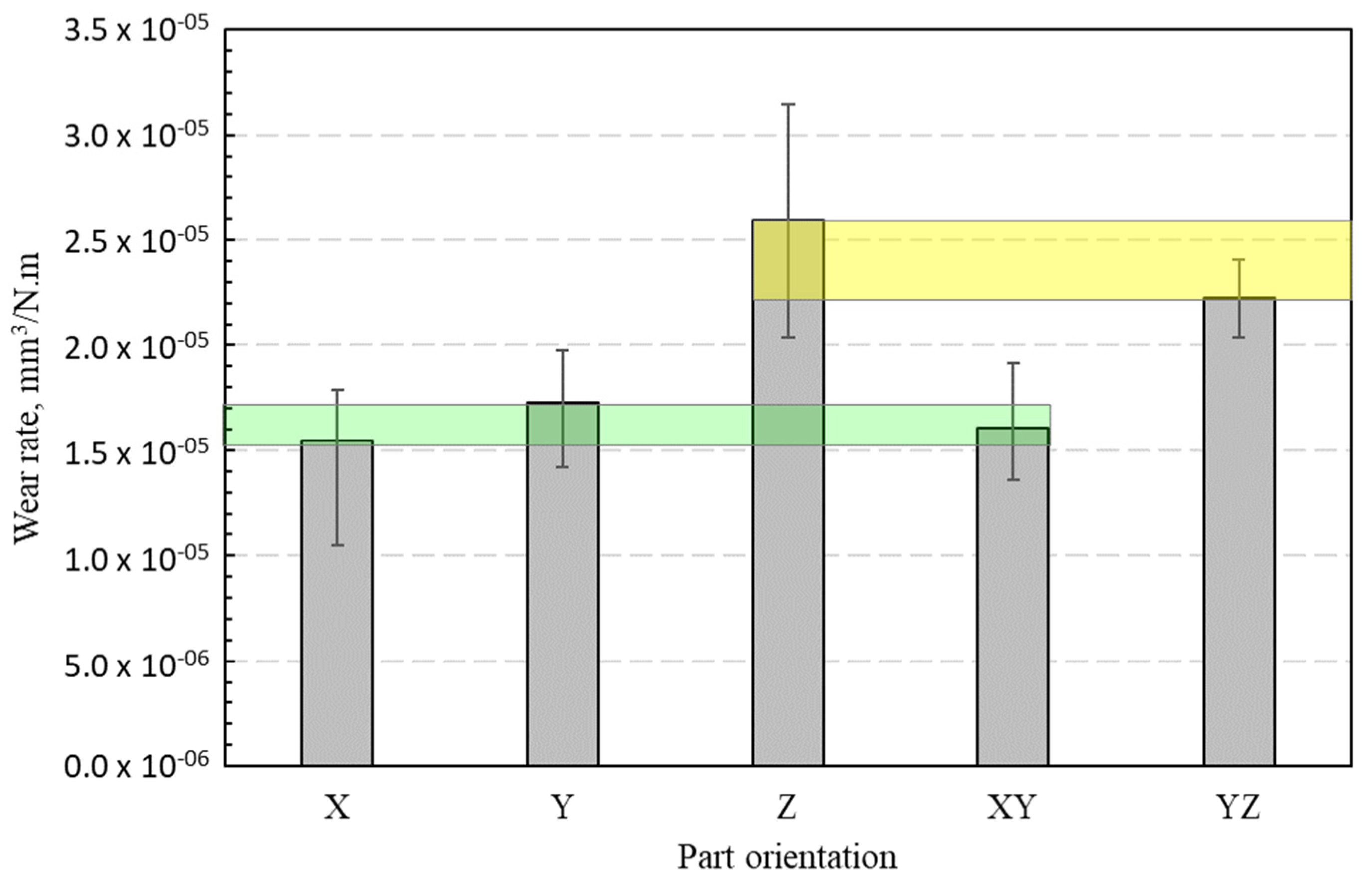



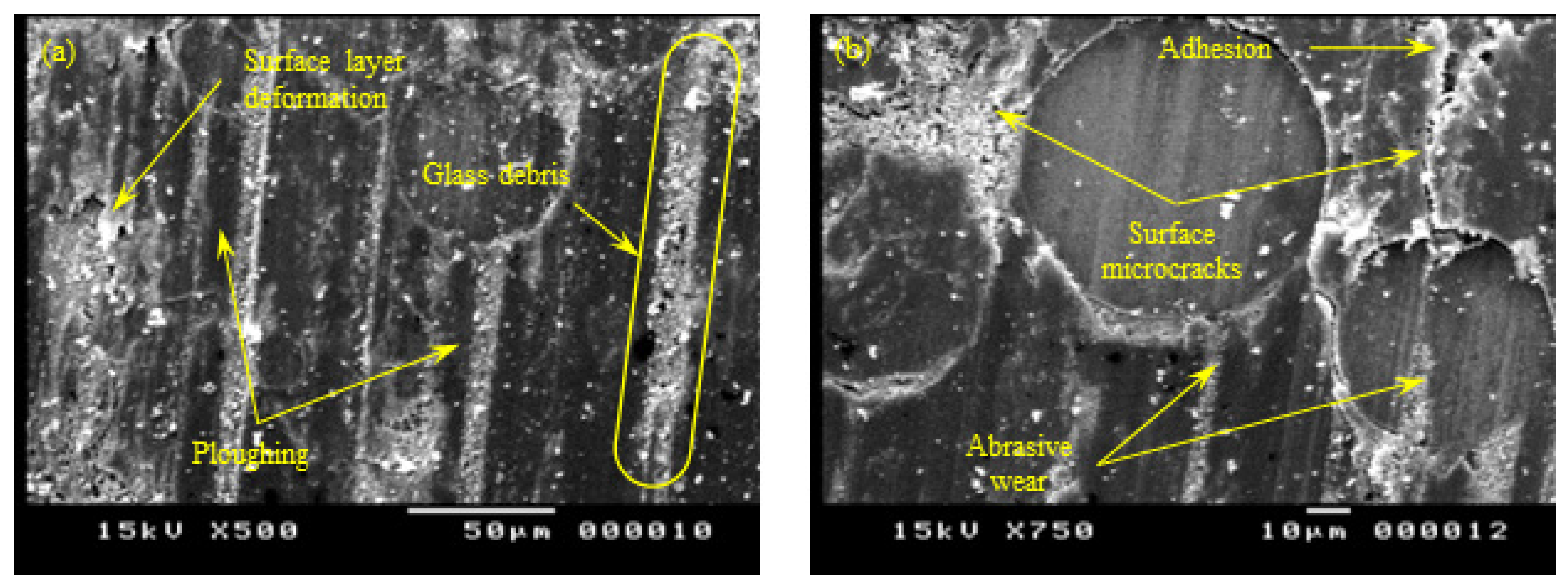

| Powder | PA3200GF |
| SLS machine | EOS P380 Machine |
| Layer thickness (mm) | 0.15 |
| Outline power (W) | 14.48 and 700 |
| Outline scanning speed (mm/s) | 700 |
| Hatching power (W) | 22.4 |
| Hatching speed (mm/s) | 2000 |
| Scan spacing (mm) | 0.3 |
| Normal load (N) | 50 |
| Rotation speed (rpm) | 120 |
| Sliding speed (m/s) | 0.25 |
| Sliding track radius (mm) | 20 |
| Test duration (min) | 45 |
| Initial temperature (°C) | 29–30 |
| Background noise level (dB) | 35–37 |
| Humidity (%) | 7–10 |
| Average Steady State | Specimen Orientation | ||||
|---|---|---|---|---|---|
| X | Y | Z | XY | YZ | |
| COF | 0.3301 | 0.3369 | 0.3299 | 0.3435 | 0.3199 |
| Noise level (dB) | 48.9 | 48.8 | 48.1 | 51.6 | 48.3 |
| Approx. interface temperature (°C) | 45.5 | 50.4 | 50.4 | 49.8 | 45.2 |
| Avg. wear depth (mm) | 0.042 | 0.047 | 0.07 | 0.043 | 0.06 |
| Wear rate (mm3/N.m) | 1.54 × 10−5 | 1.73 × 10−5 | 2.59 × 10−5 | 1.61 × 10−5 | 2.22 × 10−5 |
Disclaimer/Publisher’s Note: The statements, opinions and data contained in all publications are solely those of the individual author(s) and contributor(s) and not of MDPI and/or the editor(s). MDPI and/or the editor(s) disclaim responsibility for any injury to people or property resulting from any ideas, methods, instructions or products referred to in the content. |
© 2023 by the authors. Licensee MDPI, Basel, Switzerland. This article is an open access article distributed under the terms and conditions of the Creative Commons Attribution (CC BY) license (https://creativecommons.org/licenses/by/4.0/).
Share and Cite
Gadelmoula, A.; Aldahash, S.A. Tribological Properties of Glass Bead-Filled Polyamide 12 Composite Manufactured by Selective Laser Sintering. Polymers 2023, 15, 1268. https://doi.org/10.3390/polym15051268
Gadelmoula A, Aldahash SA. Tribological Properties of Glass Bead-Filled Polyamide 12 Composite Manufactured by Selective Laser Sintering. Polymers. 2023; 15(5):1268. https://doi.org/10.3390/polym15051268
Chicago/Turabian StyleGadelmoula, Abdelrasoul, and Saleh Ahmed Aldahash. 2023. "Tribological Properties of Glass Bead-Filled Polyamide 12 Composite Manufactured by Selective Laser Sintering" Polymers 15, no. 5: 1268. https://doi.org/10.3390/polym15051268
APA StyleGadelmoula, A., & Aldahash, S. A. (2023). Tribological Properties of Glass Bead-Filled Polyamide 12 Composite Manufactured by Selective Laser Sintering. Polymers, 15(5), 1268. https://doi.org/10.3390/polym15051268





